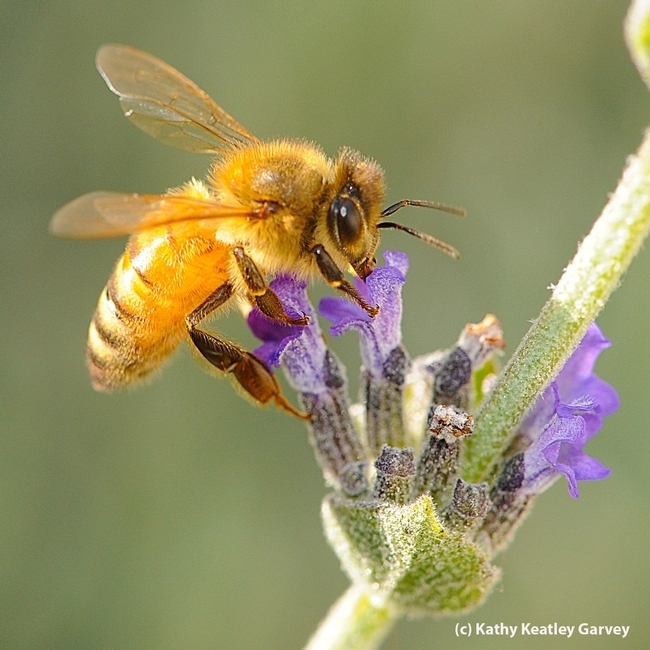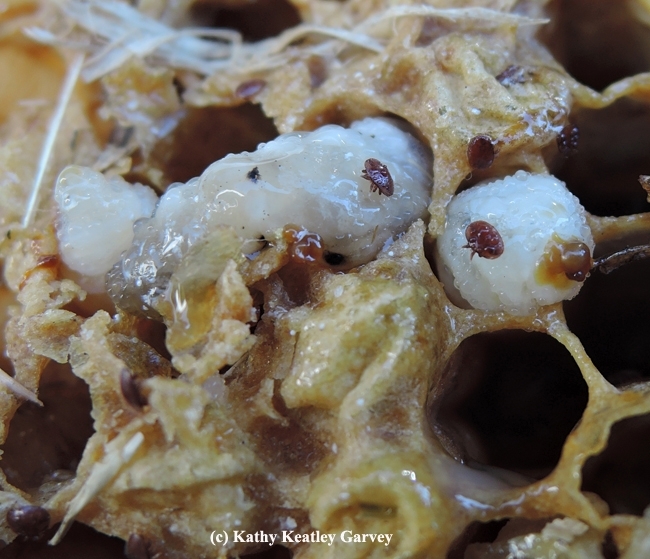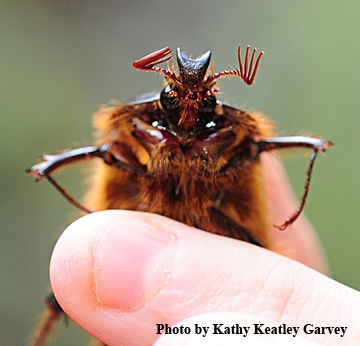- Author: Kathy Keatley Garvey
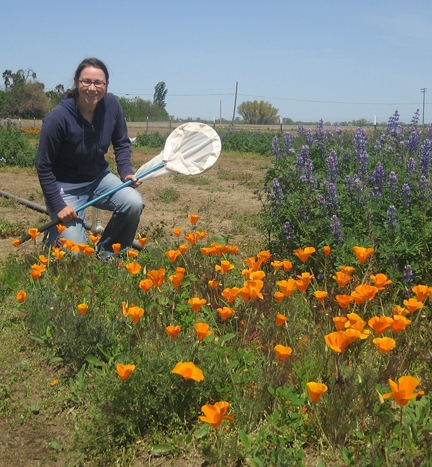
Mark your calendar for Tuesday, March 15 for a two-hour workshop, "Almond Pollination and Orchard Pollinator Planters" in Zamora, Yolo County. It's free and open to the public.
UC Davis pollination ecologists and other experts will be among those speaking at the event, to take place from 9 a.m. to 11 a.m. at 8304 County Road 91B, Zamora. No reservations are required.
“This field day will provide an overview of integrated crop pollination and on-farm wildflower plantings for almonds in the Sacramento Valley,” said organizer Katharina Ullmann, who received her doctorate in entomology from UC Davis last year with major professor and pollination ecologist Neal Williams. She is now a pollination specialist for the Xerces Society for Invertebrate Conservation.
“We will hear the latest research from a UC Davis lab studying almond pollination and wildflower plantings, learn about almond pollinators and how to support those pollinators using wildflowers," Ullmann said. "We will also discuss establishment and maintenance practices for planting habitat on field crop edges and provide an overview of plant species appropriate for plantings in the Sacramento Valley and beyond. Two growers will share their perspectives."

The March 15 lineup:
9 a.m.: Welcome by Kat Pope, orchard advisor, UC Cooperative Extension, Sacramento, Solano and Yolo counties; and Rachael Long, owner of the DH Long Farm and Yolo County farm advisor
9:10: Integrated crop pollination, almond pollination and research update by Kimiora Ward, research associate, Neal Williams lab, UC Davis; Ola Lundin, postdoctoral researcher, Williams lab, and Katharina Ullmann, crop pollination specialist, Xerces Society
9:40: Almond wildflower plantings 101 (DH Long Farm) by Kimiora Ward, research associate, Williams lab; Kitty Bolte, junior research specialist, Williams lab; and Tom Barrios, Barrios Farms
10:25: Solarization for wildflower planting success (Tadlock Farm) by Jessa Kay Cruz, pollinator conservation specialist, Xerces Society; orchard manager, Tadlock Farm
10:45: Technical and financial support, Ha Troung, Yolo County, Natural Resources Conservation Service (NRCS)
The sponsors include UC Agriculture and Natural Resources, UC Davis, Xercies Society, Integrated Crop Pollination Project Colusa County Resource Conservation District, and the Yolo County Resource Conservation District.
Continuing education credits will be given. Participants are asked to bring a hat, sunscreen and good walking shoes. For more information contact Katharina Ullmann at katharina@xerces.org or at (530) 302-5504.

- Author: Kathy Keatley Garvey

Feb. 14 was a perfect day for foragers, as the temperature climbed into the '70s, an unusually warm February day.
The site: The Glen Cove Marina in Vallejo, Calif., across the Carquinez Straits from Crockett.
We focused on one Bombus vosnesenskii--but only because the other four buzzed out of camera range. For 10 minutes, we watched her work the rosemary, buzzing from flower to flower as honey bees and syrphid flies zeroed in for their share, too.
But look at the bumble bee's pollen load, reminiscent of Halloween candy corn, those triangle-shaped yellow, orange and white-layered sweets.
"She obviously switched from one plant species with pale pollen to one with orangish pollen and maybe back again during her foraging bout," noted native polinator specialist Robbin Thorp, distinguished emeritus professor of entomology at UC Davis and co-author of California Bees and Blooms: A Guide for Gardeners and Naturalists (Heydey) and Bumble Bees of North America: An Identification Guide (Princeton University Press.)
"A fickle forager," Thorp declared. "Rosemary has whitish pollen, but it is usually a nectar resource for honey bees and others. So there must be some other plants being visited by B. vos. females in the area."
Indeed there were. California golden poppy (the state flower), wild radish, oxalis, and mustard.
"Detective" Thorp quickly figured it out. "The wild radish, mustard, and oxalis all have yellow pollen. Poppy has orange pollen. So it looks like your female may have started on rosemary (upper whitish part of the load), moved over to poppy for a while, and back to rosemary (bottom pale part of the load). Since poppy produces no nectar, visits to rosemary are primarily to tank up on nectar for flight fuel and apparently to collect some pollen there as well. It is often said that a mix of different pollen types is best for bees, so she is picking up a balanced diet for her babies."
Bottom line: When you capture an image of a bumble bee, you may not know where it's going, but a top-notch pollinator specialist can tell you where it's been!



- Author: Kathy Keatley Garvey
Honey bees aren't the only bees out foraging.
We saw our first native bee of the season on Jan. 25 at the Benicia Capitol State Historic Park.
Native pollinator specialist Robbin Thorp, distinguished emeritus professor of entomology at the UC Davis Department of Entomology and Nematology, identified it as a female sweat bee, Halictus rubicundus.
"The head shape, lack of long curled hairs below at the base of the hind leg, and the bent basal vein in the wing" helped him identify it as a Halictus. The lack of facial foveae confirmed it was not an Andrena.
"Nice early record for this species," added Thorp, who is the co-author of California Bees and Blooms: A Guide for Gardeners and Naturalists (Heydey) and Bumble Bees of North America: An Identification Guide (Princeton University Press.)
Halicutus rubicundus is found in Europe, northern Asia, and across the United States and Canada, according to the book, The Bees in Your Backyard, A Guide to North America's Bees, by Joseph S. Wilson, assistant professor of biology at Utah State University, and Olivia J. Messinger Carril, who received her doctorate in plant biology from Southern Illinois University and "has been studying bees and wasps for more than a decade," according to the publisher, Princeton University Press.
You can see more images of this sweat bee on BugGuide.Net.
So, one sweat bee down. Hundreds more to go as the seasons unfold.
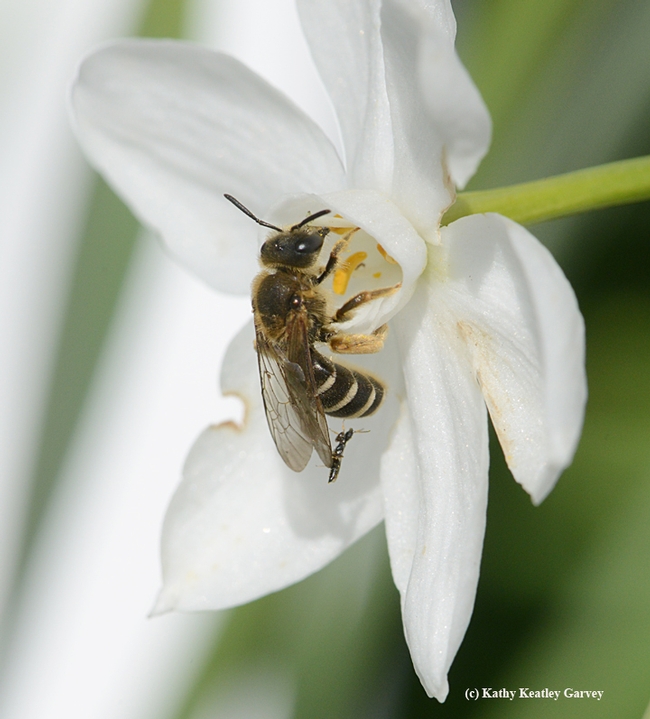

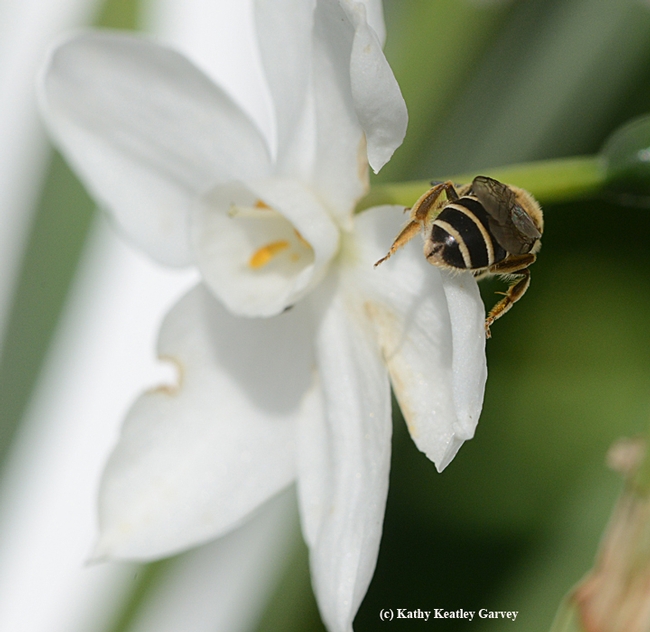
- Author: Kathy Keatley Garvey
It's good for the drought and it's good for the rain beetles.
If you've never seen a rain beetle (genus Pleocoma) no worries. Most people haven't, either. You have to be in the right place at the right time, which amounts to being in a fall or winter rainstorm in their habitat before sunrise or just after sunset. And you have to work quickly. The males can fly only a couple of hours before they die. The females are flightless.
We saw our first--and last--rain beetles back in October of 2012 when a graduate student in the UC Davis Department of Entomology and Nematology showed us several that a friend had been collected in the Shenandoah Valley of Plymouth, Amador County.
What intriguing insects! They spend most of their lives in immature stages beneath the ground, and that can total a decade or more, scientists estimate. The adults surface when the ground is soaked.
You'll never seen adult beetles eat because they don't. They have no mouthparts or digestive tracts. They rely on the fat stored from their larval stage.
The females emit a pheromone so the males can locate them. It's a hurry-hurry-hurry scenario. Arthur Evans and James Hogue, authors of Introduction to California Beetles (University of California Press, Berkeley) say that “on average, males of some rain beetles have only enough energy stored as fat to give them about two hours of air time and live only a few days. The more sedentary females require less energy and may live for months after fall and winter storms.”
In California, "Pleocoma is found only in foothill and mountain habitats, never on the valley floor that I know of,” Lynn Kimsey director of the Bohart Museum of Entomology and professor of entomology at UC Davis, told us. “A lot of the populations have been extirpated by housing developments. When I was a kid living in the Berkeley Hills in El Cerrito we had lots of males flying after every rain but once the neighborhood was built up they vanished.”
“California's rain beetles occur throughout the mountainous regions of the state, except in the deserts,” according to Evans and Hogue. Their excerpt on rain beetles is published on the website of the Hastings Natural History Reservation in Carmel, Monterey County. “Small, isolated populations also occur in the Sacramento Valley and the coastal plain of San Diego County. The known modern distribution of these apparently ancient beetles is restricted by the flightless females and is more or less correlated to areas of land that have never been subjected to glaciation or inundation by inland seas during the last two or three million years.”
As underground larvae, these insects feed on shrub and tree roots, fungi and other organic matter. Larvae can be pests when they attack the roots of apple, pear and other orchard trees.
Evans and Hogue describe the rain beetles as “large, robust, and shiny.”
And hairy. Indeed, Pleocoma is Greek for abundant hair.
“The thick layer of hair covering the undersides," they write, "is remarkably ineffective as insulation, especially for flying or rapidly crawling males who must maintain high body temperatures in cold, damp weather….the thick pile probably functions to protect both sexes from abrasion as they burrow through the soil. Males and females dig with powerful, rake-like legs and a V-shaped scoop mounted on the front of the head.”
“In most species of rain beetles, male activity is triggered by weather conditions that accompany sufficient amounts of fall or winter rainfall or snowmelt in late winter or early spring. Depending upon circumstances, males may take to the air at dawn or at dusk, or they may fly during evening showers. Others are encountered flying late in the morning on sunny days following a night of pouring rains, or during heavy snowmelt.”
Evans and Hogue say the males fly low to the ground searching for females. They are often attracted to lights (including porch lights) and pools of water. “Females crawl back down their burrows and may wait up to several months for their eggs to mature. The female eventually lays 40 to 50 eggs in a spiral pattern at the end of the burrow as much as 3 m (10 ft) below the surface. The eggs hatch in about two months.”
You can also find more information on these fascinating insects on Wikipedia, BugGuide.net, Washington State University, and YouTube, including:

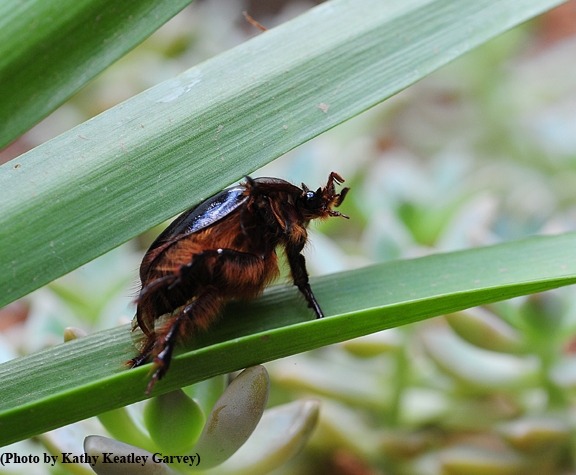


- Author: Kathy Keatley Garvey
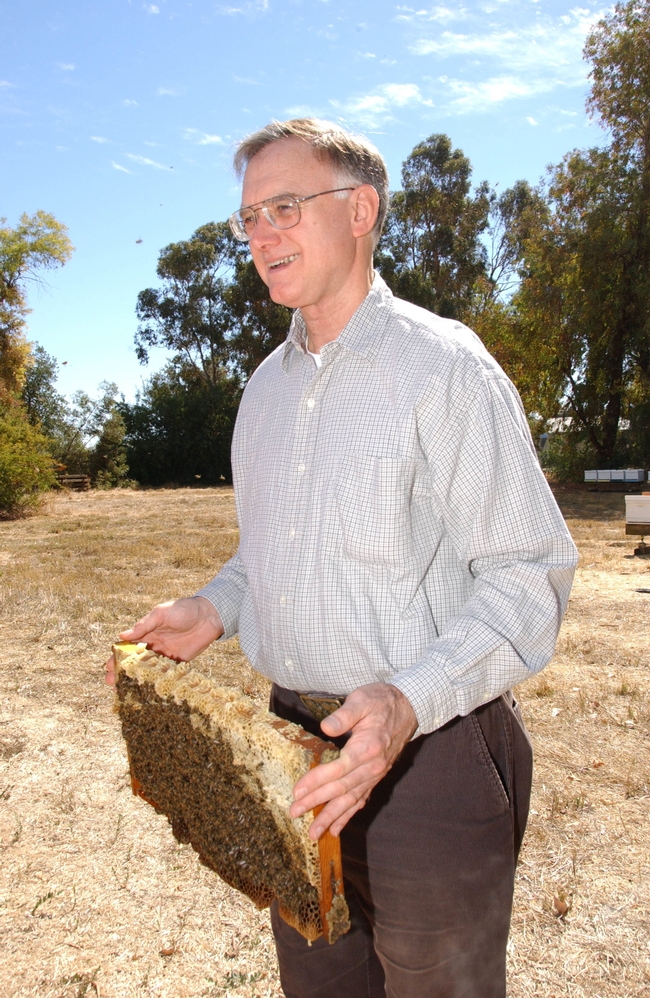
You've heard "The 12 Days of Christmas," beginning with a single "partridge in a pear tree" and ending with "12 drummers drumming." In between: two turtle doves, three french hens, four calling birds, five gold rings, six geese-a-laying, seven swans-a-swimming, eight maids-a-milking, nine ladies dancing, 10 lords-a-leaping, and 11 pipers piping.
But have you heard "The 13 Bugs of Christmas?"
Back in 2010, Extension apiculturist Eric Mussen of the UC Davis Department of Entomology (now the UC Davis Department of Entomology and Nematology) and yours truly came up with a song about "The 13 Bugs of Christmas." Presented at the Department of Entomology's holiday party, it drew roaring applause. Then U.S. News featured it when reporter Paul Bedard picked it up.
It's still making the rounds, via social media, and it's also appeared in number of pubications, including a pest control magazine.
"The 13 Bugs of Christmas" is about a psyllid in a pear tree, six lice a'laying, 10 locusts leaping and 11 queen bees piping. Beekeepers know that distinctive sound of a queen bee piping.
"We attempted to keep the wording as close as possible for ‘The 12 Bugs of Christmas' and then we opted to spotlight some new agricultural pests in the next stanza," said Mussen, who retired in June 2014 after 38 years of service.
The song:
On the first day of Christmas, my true love gave to me, a psyllid in a pear tree.
On the second day of Christmas, my true love gave to me, two tortoises beetles and a psyllid in a pear tree
On the third day of Christmas, my true love gave to me, three French flies, two tortoise beetles and a psyllid in a pear tree
On the fourth day of Christmas, my true love gave to me, four calling cicadas, three French flies, two tortoise beetles and a psyllid in a pear tree
On the fifth day of Christmas, my true love gave to me five golden bees, four calling cicadas, three French flies, two tortoise beetles and a psyllid in a pear tree
On the sixth day of Christmas, my true love gave to me six lice a'laying, five golden bees, four calling cicadas, three French flies, two tortoise beetles and a psyllid in a pear tree
On the seventh day of Christmas, my true love gave to me seven boatmen swimming, six lice a'laying, five golden bees, four calling cicadas, three French flies, two tortoise beetles and a psyllid in a pear tree
On the eighth day of Christmas, my true love gave to me eight ants a'milking, seven boatmen swimming, six lice a'laying, five golden bees, four calling cicadas, three French flies, two tortoise beetles and a psyllid in a pear tree
On the ninth day of Christmas, my true love gave to me nine mayflies dancing, eight ants a'milking, seven boatmen swimming, six lice a'laying, five golden bees, four calling cicadas, three French flies, two tortoise beetles and a psyllid in a pear tree
On the tenth day of Christmas, my true love gave to me 10 locusts leaping, nine mayflies dancing, eight ants a'milking, seven boatmen swimming, six lice a'laying, five golden bees, four calling cicadas, three French flies, two tortoise beetles and a psyllid in a pear tree
On the 11th day of Christmas, my true love gave to me 11 queen bees piping, 10 locusts leaping, nine mayflies dancing, eight ants a'milking, seven boatmen swimming, six lice a'laying, five golden bees, four calling cicadas, three French flies, two tortoise beetles and a psyllid in a pear tree
On the 12th day of Christmas, my true love gave to me 12 deathwatch beetles drumming, 11 queen bees piping, 10 locusts leaping, nine mayflies dancing, eight ants a'milking, seven boatmen swimming, six lice a'laying, five golden bees, four calling cicadas, three French flies, two tortoise beetles and a psyllid in a pear tree
Knowing the agony that Californians experience with the seemingly unending flood of pests, Mussen felt it "bugworthy" to add this verse:
"On the 13th day of Christmas, Californians woke to see:
13 Kaphra beetles,
12 Diaprepes weevils,
11 citrus psyllids,
10 Tropilaelaps clareae,
nine melon fruitflies,
eight Aedes aegypti,
seven ash tree borers,
six spotted-wing Drosophila,
five gypsy moths,
four Japanese beetles,
three imported fire ants,
two brown apple moths,
and a medfly in a pear tree."
Mussen noted that Tropilaelaps clareae is a honey bee mite from Asia, as is the well-known varroa mite (Varroa destructor), which was first detected in the United States (Wisconsin) in 1987 and is now beekeepers' No. 1 problem.
It's unlikely, however, that Tropilaelaps clareae and Varroa destructor will become part of any other Christmas song...but you never know...
